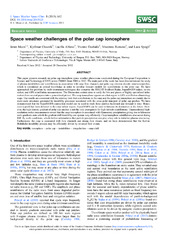| dc.contributor.author | Moen, Jøran Idar | |
| dc.contributor.author | Oksavik, Kjellmar | |
| dc.contributor.author | Alfonsi, Lucilla | |
| dc.contributor.author | Dåbakk, Yvonne Rinne | |
| dc.contributor.author | Romano, Vineenzo | |
| dc.contributor.author | Spogli, Luca | |
| dc.date.accessioned | 2016-08-03T06:30:16Z | |
| dc.date.available | 2016-08-03T06:30:16Z | |
| dc.date.issued | 2013 | |
| dc.Published | Journal of Space Weather and Space Climate 2013, 3:A02 | eng |
| dc.identifier.issn | 2115-7251 | en_US |
| dc.identifier.uri | https://hdl.handle.net/1956/12399 | |
| dc.description.abstract | This paper presents research on polar cap ionosphere space weather phenomena conducted during the European Cooperation in Science and Technology (COST) action ES0803 from 2008 to 2012. The main part of the work has been directed toward the study of plasma instabilities and scintillations in association with cusp flow channels and polar cap electron density structures/patches, which is considered as critical knowledge in order to develop forecast models for scintillations in the polar cap. We have approached this problem by multi-instrument techniques that comprise the EISCAT Svalbard Radar, SuperDARN radars, in-situ rocket, and GPS scintillation measurements. The Discussion section aims to unify the bits and pieces of highly specialized information from several papers into a generalized picture. The cusp ionosphere appears as a hot region in GPS scintillation climatology maps. Our results are consistent with the existing view that scintillations in the cusp and the polar cap ionosphere are mainly due to multi-scale structures generated by instability processes associated with the cross-polar transport of polar cap patches. We have demonstrated that the SuperDARN convection model can be used to track these patches backward and forward in time. Hence, once a patch has been detected in the cusp inflow region, SuperDARN can be used to forecast its destination in the future. However, the high-density gradient of polar cap patches is not the only prerequisite for high-latitude scintillations. Unprecedented high-resolution rocket measurements reveal that the cusp ionosphere is associated with filamentary precipitation giving rise to kilometer scale gradients onto which the gradient drift instability can operate very efficiently. Cusp ionosphere scintillations also occur during IMF BZ north conditions, which further substantiates that particle precipitation can play a key role to initialize plasma structuring. Furthermore, the cusp is associated with flow channels and strong flow shears, and we have demonstrated that the Kelvin-Helmholtz instability process may be efficiently driven by reversed flow events. | en_US |
| dc.language.iso | eng | eng |
| dc.publisher | EDP Sciences | en_US |
| dc.rights | Attribution CC BY | eng |
| dc.rights.uri | http://creativecommons.org/licenses/by/2.0/ | eng |
| dc.subject | ionosphere | eng |
| dc.subject | polar cap | eng |
| dc.subject | instabilities | eng |
| dc.subject | irregularities | eng |
| dc.subject | cusp-cleft | eng |
| dc.title | Space weather challenges of the polar cap ionosphere | en_US |
| dc.type | Peer reviewed | |
| dc.type | Journal article | |
| dc.date.updated | 2016-04-11T12:45:51Z | |
| dc.description.version | publishedVersion | en_US |
| dc.rights.holder | Copyright J. Moen et al. | en_US |
| dc.identifier.doi | https://doi.org/10.1051/swsc/2013025 | |
| dc.identifier.cristin | 1048401 | |
| dc.relation.project | Norges forskningsråd: 212014 | |
| dc.relation.project | Norges forskningsråd: 208006 | |
| dc.subject.nsi | VDP::Matematikk og naturvitenskap: 400::Geofag: 450::Meteorologi: 453 | |
| dc.subject.nsi | VDP::Mathematics and natural scienses: 400::Geosciences: 450::Meteorology: 453 | |

